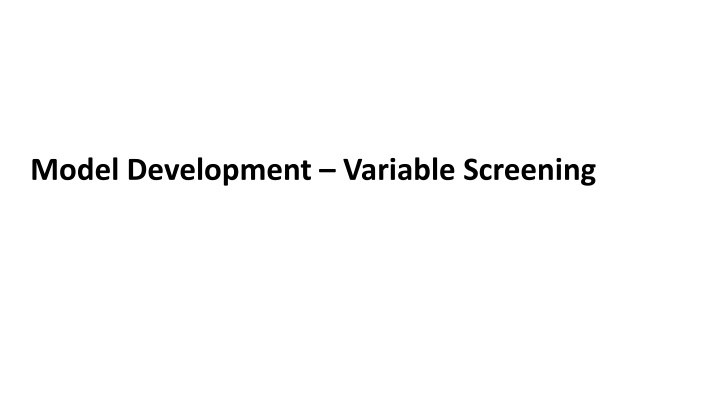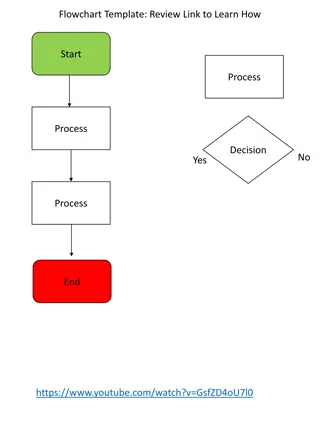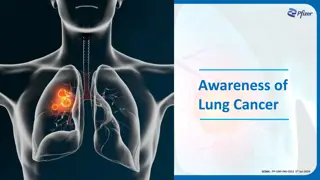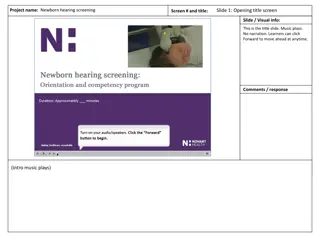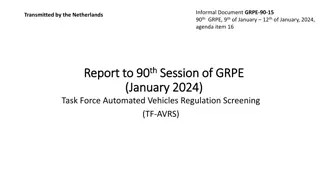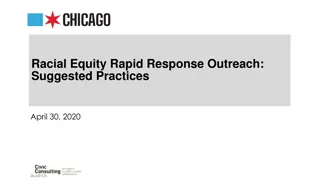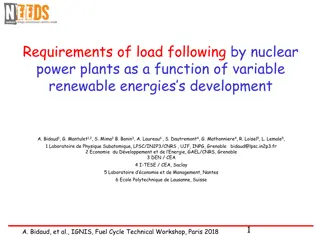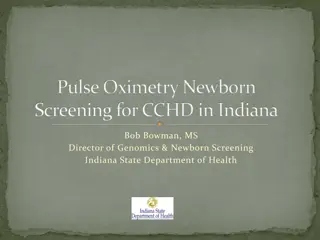Model Development Variable Screening
Utilizing principles of parsimony, this project focuses on variable screening and dimension reduction techniques, such as univariate examination of main effects and continuous target categorical analysis. The process involves screening variables based on a quick assessment of chd2018_a data and conducting t-tests, correlations with Pearson and Spearman methods, and Hoeffding's D for association detection.
Download Presentation

Please find below an Image/Link to download the presentation.
The content on the website is provided AS IS for your information and personal use only. It may not be sold, licensed, or shared on other websites without obtaining consent from the author.If you encounter any issues during the download, it is possible that the publisher has removed the file from their server.
You are allowed to download the files provided on this website for personal or commercial use, subject to the condition that they are used lawfully. All files are the property of their respective owners.
The content on the website is provided AS IS for your information and personal use only. It may not be sold, licensed, or shared on other websites without obtaining consent from the author.
E N D
Presentation Transcript
Variable Screening AKA Dimension Reduction A more or less universally accepted principle: Principle of Parsimony
Variable screening Univariate examination of candidate main effects.
proc proc contents contents data=a.chd2018_a position; run run;
proc proc freq tables age--currsmok/noprint; run run; freq data=a.chd2018_a nlevels;
Continuous Target Categorical All categorical variables are coded 0,1
t-tests /*a quick screen -- ttests*/ %let target=chd; %let continuous=age pulse chol hematocrit fvcht sbp bmi; %let categorical=diab male mi_chol mi_hem currsmok; ods select ttests; proc proc ttest ttest data=a.chd2018_a nobyvar plots=none; class ⌖ var &continuous &categorical; run run;
Spearman Pearson correlation of ranks. Less sensitive to nonlinearities and outliers than the Pearson
Hoeffdings D detects a wide variety of associations between two variables.
/* another quick screen*/ %let target=chd; %let continuous=age pulse chol hematocrit fvcht sbp bmi; %let categorical=diab male mi_chol mi_hem currsmok; proc proc corr var ⌖ with &continuous &categorical; run run; corr data=a.chd2018_a spearman hoeffding;
/* another quick screen univariate models (partial)*/ %clearall clearall ods select parameterestimates; proc proc logistic logistic data=a.chd2018_a descending; model chd=age; run run; ods select parameterestimates; proc proc logistic logistic data=a.chd2018_a descending; model chd=pulse; run run; ods select parameterestimates; proc proc logistic logistic data=a.chd2018_a descending; model chd=chol; run run; ods select parameterestimates; proc proc logistic logistic data=a.chd2018_a descending; model chd=hematocrit; run run;
%macro %macro all_univ_betas(data=, depvar=, event=, indepvars=); %let numvars=%sysfunc(countw(&indepvars)); %put "Number of variables: " &numvars; %do i=1 1 %to &numvars; %let univ=%scan(&indepvars,&i);/*get ith variable*/ proc logistic data=&data; ods select parameterestimates; model &depvar(event="&event")=&univ; run; %end; %mend %mend;
%clearall clearall %let target=chd; %let continuous=age pulse chol hematocrit fvcht sbp bmi; %let categorical=diab male mi_chol mi_hem currsmok; options mprint; %all_univ_betas all_univ_betas(data=a.chd2018_a, depvar=chd, event=1 1, indepvars=&continuous &categorical) options nomprint;
A simple macro %macro %macro all_logit_plots(data=, %let numvars=%sysfunc(countw(&indepvars)); %put "Number of variables: " &numvars; depvar=, indepvars=); %do i=1 1 %to &numvars; %let univ=%scan(&indepvars,&i);/*get ith variable*/ %PlotLogits PlotLogits(indata=&data,numgrp=10 indepvar=&univ,depvar=&depvar); %end; 10, %mend %mend;
%clearall clearall %let target=chd; %let continuous=age pulse chol hematocrit fvcht sbp bmi; %let categorical=diab male mi_chol mi_hem currsmok; options mprint; %all_logit_plots all_logit_plots(data=a.chd2018_a, depvar=chd, indepvars=&continuous); options nomprint;
proc proc loess loess data=a.chd2018_a; model chd=bmi/smooth=.25 output out=smoothed predicted=phat; run run; proc proc sort sort data=smoothed; by smoothingparameter bmi; run run; data data smoothed; set smoothed; where 0 0<phat<1 1; logit=log(phat/(1 1-phat)); proc proc sgplot sgplot data=smoothed; series x=bmi y=logit/group=smoothingparameter lineattrs=(thickness=3 3); run run; .25 .5 .5 .75 .75 1 1 1.25 1.25 1.5 1.5;
proc proc loess loess data=a.chd2018_a; where bmi between 20 model chd=bmi/smooth=.25 output out=smoothed predicted=phat; run run; proc proc sort sort data=smoothed; by smoothingparameter bmi; run run; data data smoothed; set smoothed; where 0 0<phat<1 1; logit=log(phat/(1 1-phat)); proc proc sgplot sgplot data=smoothed; series x=bmi y=logit/group=smoothingparameter lineattrs=(thickness=3 3); run run; 20 and 32 .25 .5 32; .5 .75 .75 1 1 1.25 1.25 1.5 1.5;
An easier to modify program. %clearall clearall %let var=chol; proc proc loess loess data=a.chd2018_a; model chd=&var/smooth=.25 output out=smoothed predicted=phat; run run; proc proc sort sort data=smoothed; by smoothingparameter &var; run run; data data smoothed; set smoothed; where 0 0<phat<1 1; logit=log(phat/(1 1-phat)); proc proc sgplot sgplot data=smoothed; series x=&var y=logit/group=smoothingparameter lineattrs=(thickness=3 3); run run; .25 .5 .5 .75 .75 1 1 1.25 1.25 1.5 1.5;
%clearall clearall %let var=fvcht; proc proc loess loess data=a.chd2018_a; model chd=&var/smooth=.25 output out=smoothed predicted=phat; run run; proc proc sort sort data=smoothed; by smoothingparameter &var; run run; data data smoothed; set smoothed; where 0 0<phat<1 1; logit=log(phat/(1 1-phat)); proc proc sgplot sgplot data=smoothed; series x=&var y=logit/group=smoothingparameter lineattrs=(thickness=3 3); run run; .25 .5 .5 .75 .75 1 1 1.25 1.25 1.5 1.5;
Variable Screening Variable Clustering 31
Variable Clustering Example title; data data simpcorr (type=CORR); input _name_ $2. @4 4 _type_ $4. x1 x2 x3 x4 x5 x6; datalines; x1 CORR 1 -.11 -.03 -.69 -.04 .07 X2 CORR -.11 1 -.14 .07 .04 .73 X3 CORR -.03 -.14 1 .04 -.73 .09 X4 CORR -.69 .07 .04 1 .02 .07 X5 CORR -.04 .04 -.73 .02 1 .05 X6 CORR .07 .73 .09 .07 .05 1 ; run run; proc proc contents contents data=simpcorr;run proc proc print print data=simpcorr;run run; run;
Variable Clustering Variable clustering finds groups of variables that are as correlated as possible among themselves and as uncorrelated as possible with variables in other clusters. The basic algorithm is binary and divisive. All variables start in one cluster. A principal components analysis is done on the variables in the cluster.
If the second eigenvalue is greater than a specified threshold (in other words, there is more than one dominant dimension), then the cluster is split. The PC scores are then rotated obliquely so that the variables can be split into two groups. This process is repeated for the two child clusters until the second eigenvalue drops below the threshold.
The VARCLUS Procedure PROC VARCLUS DATA=SAS-data-set<options>; VARvariables; RUN; proc proc varclus varclus data=simpcorr;run run; 37
data data bodym; set nhanes3.bodymeasurements (drop=BMPWTFLG BMPHTFLG); run run; proc proc contents contents data=bodym position; run run; proc proc corr corr data=bodym; var bm:; run run;
proc proc varclus varclus data=bodym minclusters=3 3; var bm:; run run;
We formed clusters. What now? Pick one variable from each cluster. Principal components by cluster.
